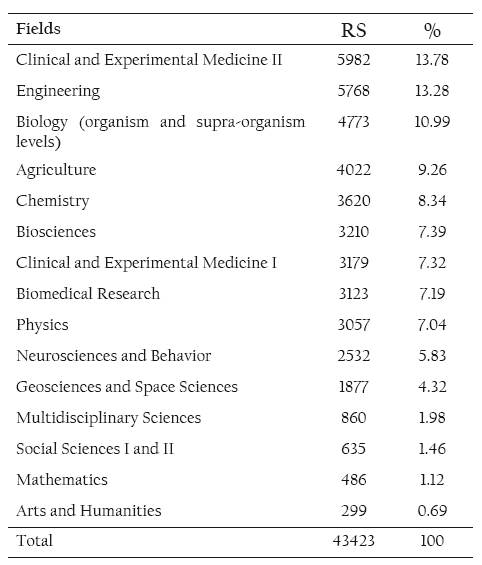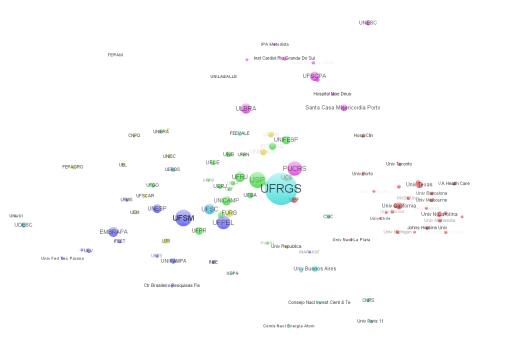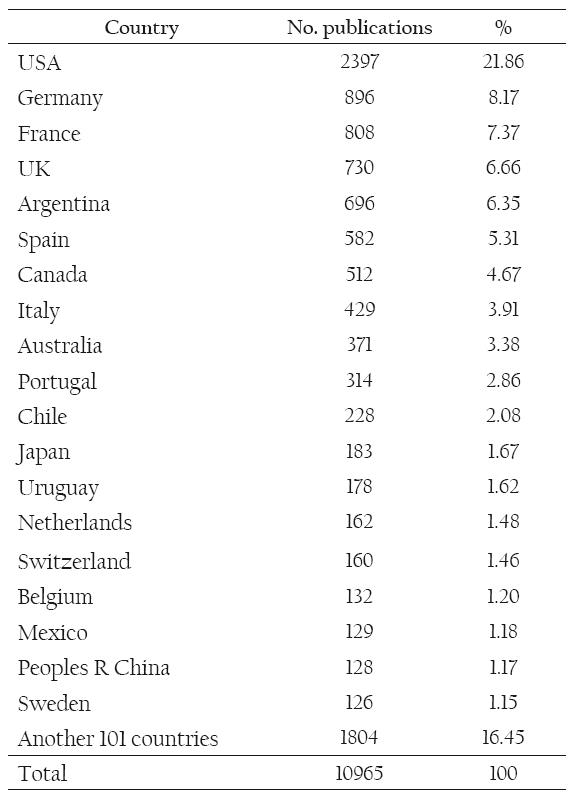1. Introduction
Assessing scientific output is a common practice adopted by development agencies, governmental departments, and bodies connected to S&T in several countries. Such assessments have proven essential to develop S&T indicators, subsequently distribute investments, develop local and institutional strategies, and evaluate the results from the policies implemented. S&T indicator-related practices have sparked special interest in nations whose scientific output is growing fast.
Brazil realized scientific research was important only in the late 19th century (The present..., 1883). In 2006, Brazil’s production was the fastest growing among Latin American countries, recording an 8% annual increase in the Web of Science (WoS) database (Glänzel, Leta & Thijs, 2006). In 2008, the country ranked 13th worldwide in terms of scientific output indexed in WoS, aided by the increased number of Brazilian journals included in that database (Packer, 2011). Today, Brazil holds the same position in WoS and stands at 15th in SCOPUS’ country productivity ranking3 . However, the country is still timid when it comes to developing S&T indicators and lacks an information tool capable of characterizing and sizing the state systems of science, technology and innovation (Rocha & Ferreira, 2004), despite the questions raised by the pace at which Brazil’s scientific output is expanding. In such backdrop, questions as to the way the number of publications has been increasing, in which outlets and where the papers are being published and by means of which partnerships are yet to be answered.
Besides the lack of studies regarding Brazil as a whole, we find that an even greater unknown is the situation of scientific research and publication in the states. Brazilian states differ in terms of their scientific output, which differences stem mostly from their unequal social and economic development. It is vital to conduct studies into the Brazilian scientific output and its share worldwide, and such studies should include the particularities and interests of the country and its regions, states, cities, and institutions (FAPESP, 2010). As stated by Albuquerque, Simões, Baessa, Campolina, and Leandro (2002): “The country’s continental and federative nature requires an analysis of regional differences, at the same time said analysis introduces the potential role of building local and state innovation systems in the country.” (p. 230). Therefore, specific situations also need to be identified.
The State of São Paulo has pioneered the efforts to map its scientific output. The mapping is an initiative by the state’s research support foundation, the Fundação de Amparo à Pesquisa do Estado de São Paulo (FAPESP). The FAPESP Science, Technology and Innovation Indicator Program is meant to report on statistics and indicators that reflect the recent situation and the main trends in the state’s scientific and technological activities, and compare them to Brazilian and international efforts and results (FAPESP, 2004, 2010). The program has resulted in the publication of the São Paulo State Science, Technology and Innovation Indicators, a report about the situation in the state.
A similar initiative is underway in Rio Grande do Sul, a state located in the Brazilian far south and home to 10,693,929 people, equivalent to approximately 5% of the Brazilian population, and standing out as the 4th largest economy in the country (Instituto Brasileiro, 2010). The state is renowned for housing some of the most productive universities in Brazil, such as Universidade Federal do Rio Grande do Sul (UFRGS) and Pontifícia Universidade Católica do Rio Grande do Sul (PUCRS) (Vanz, 2009; Moura, 2009). The south, where the state is located, is the second largest out of the five regions in which the country is divided in terms of scientific output, and its growth rate exceeded 60% in 2002-2006 (FAPESP, 2010).
Other data previously published are related to investments made in science and technology in the state. According to the Science, Technology and innovation Index proposed by Rocha and Ferreira (2004), Rio Grande do Sul is in a second stage among the most advanced Brazilian states, along with Rio de Janeiro and Santa Catarina, and closely following São Paulo. The index comprises several indicators, including the percentage over the total expenditures in science and technology in the state (for RS, the figure is 1.09%) and the amount per person spent on science and technology, subsidized by the federal and state governments (for RS, the amount is BRL 11.35, equivalent to approximately USD 4.75). Since 1990, the RS State Constitution has mandated that 1.5% of the state’s net income is to be transferred to the Foundation. However, the average has been a meager 0.3% (Berti, Oliveira, Souza, & Wofchuk, 2010) .The National Board of Scientific and Technological Development (Conselho Nacional de Desenvolvimento Científico e Tecnológico - CNPq) census of Brazilian research groups in 2006 revealed that Rio Grande do Sul holds 10.4% of the country’s groups and 9.5% of the PhDs (FAPESP, 2010). The total number of publications indexed by WoS is included in the index as well. According to Rocha and Ferreira (2004), RS accounted for 7.72% of the articles published by Brazil in 1999. The challenge of proposing an index comprising indicators from several governmental bodies and agencies was accepted by Rocha and Ferreira (2004), and has heightened the need for even deeper studies on this topic.
The purpose of this paper is to expand the research into scientific output indicators in the state of Rio Grande do Sul. To do that, it presents the RS scientific research spectrum indexed by Web of Science from 2000 to 2010, and details the output indicators, type of document, language, fields, and publication journal, as well as the collaboration between authors, institutions and countries.
2. Methodology
The source from which data were collected was the Web of Science database posted by Thomson Reuters. WoS was searched in January 2012 in order to retrieve the highest number possible of publications by authors associated with institutions located in Rio Grande do Sul. First, we looked into the terms Brazil and Rio Grande do Sul through the advanced search option using the following expression: CU= (Brazil OR Brasil) AND PS=(RS OR RGS OR Rio Grande do Sul). Next, a more specific search strategy was employed using different expressions and names of Rio Grande do Sul research institutions and universities: OG=(name of all Rio Grande do Sul research institutions and universities). The names of Rio Grande do Sul research institutions and universities used in the search expression were obtained from the List Authorities from Brazilian Institutions, put together a few years ago by the research group (Moura, 2009; Vanz, 2009).
The search encompassed all types of documents in the 45 languages available in the database. The time filter was set for 2000-2010, and in the field reserved for choosing the citation indexes, we selected the Science Citation Index, Social Science Citation Index, and Arts & Humanities Citation Index.
After clearing out inconsistent records, we found 29,560 documents published by institutions in the state of Rio Grande do Sul. Because of namesakes and name varieties, authors and affiliated institutions were standardized based on Currículo Lattes, a platform developed by CNPq, which contains the curriculum vitae of teachers, researchers and students in a standardized format. As the information is inputted by researchers themselves, Lattes allows names and institutional connections to check in quite a reliable manner.
For comparison purposes, WoS was searched in July 2011 for documents published by Brazilian authors from 2000 to 2010, using the expression: CU= (Brazil OR Brasil).
Data were organized and analyzed through bibliometric techniques and network analysis aided by Bibexcel (Umea University), Excel 2010, and Vosviewer software.
3. Results
The total number of documents published (n=29,560) per year shows the RS scientific output’s growth between 2000 and 2010. However, the growth pace seems to fluctuate, remaining lower than the exponential growth between 2004 and 2006 and higher starting in 2006 up to 2009. For comparison purposes, Chart 1 shows the RS’ and Brazil’ s scientific output growth in WoS and the adjustment of both to the exponential growth curve (R2 0.9718 and R2 0.924, respectively)
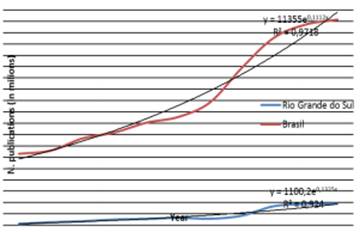
Chart 1 Growth of the Brazilian and RS’ scientific output indexed in WoS from 2000 to 2010. Research data
Table 1 shows the total number of the RS and Brazilian scientific output, revealing the growth of both over the decade. With respect to the RS scientific output, gthe growth percentages in the number of indexed documents range from 2.05% - the lowest growth between 2009 and 2010 - to the highest, 61.60% in 2007. The year 2006 showed negative growth compared to the previous year (-7.44%).
Table 1 Brazilian and Rio Grande do Sul scientific output indexed in WoS in 2000 - 2010 and inter-annual variation.

Source: Research data.
Except for 2006, when production dropped, the growth of RS output was constant throughout the period and higher than the Brazilian scientific production growth. In some years, such as 2001, 2003, 2005, 2008 e 2009, the state’s growth was higher than the Brazilian growth.
The state’s share in the national scientific production is about 10%, as shown in Table 1. We see the value is constant, ranging from 9.17% in 2000 to 12.9% in 2009. Those numbers seem to be linked to the expansion of the Brazilian higher and graduate education underway in the past two decades. For instance, in 1998 the number of Master’s and Doctoral programs totaled 1,259. In 2009, that number rose to 2,718 (Oliveira & Almeida, 2011).
In addition, the increase both in the Brazilian and state scientific output indexed in WoS is related to the significant expansion in the number of Brazilian journals indexed by Thomson Reuters. Such expansion reached nearly 700% in one decade (Packer, 2011). The highest increase took place between 2007 and 2008, especially in Rio Grande do Sul, which recorded a 61.60% variation in its scientific output in the period. A mere eight Brazilian journals were indexed in 1977 (Morel & Morel, 1977). Ten years later in 1998, 17 Brazilian titles were indexed (Targino & Garcia, 2000). The following decade, more specifically in 2008, that number had soared to 120 titles (Packer, 2011). In 2010, Brazil cemented itself with 132 journals indexed in WoS (Testa, 2011), many of them published monthly and in Portuguese, which becomes evident when we examine the search results related to the analysis of the journals’ language.
The documents were published in English (25093 documents, representing 84.89%) and Portuguese (4249, totaling 14.37%) and together account for 99.26% of the total RS output. The prevalence of English reflects the WoS indexing policy, as well as the language in which the main Brazilian journals found in the database are published, as seen in Table 2. Other languages showed up to a lesser degree, like French, German, Czech, Slovene, and Italian.
As for the types of documents published by RS researchers and indexed in WoS, despite the prevalence of the article format (71.71%), we also find Meeting Abstracts (2483 documents, 7.87%), Reviews (663 documents, 2.10%), Letters (494 documents, 1.57%), and others. Papers presented at events and published in annals are quite important for several fields of knowledge and also merit to be highlighted in our survey, as they represent 14.69% of the publications (4632 documents).
Table 2 shows a wide variety of journals in which the Rio Grande do Sul scientific output is published, in a total of 4778 titles. In order to understand such results, the group of journals publishing over 110 articles written by Rio Grande do Sul authors in the period was examined separately. That group of journals published 17.15% of the 29560 RS articles, and the remainder (82.85%) spreads out in 4754 different journals. The results show the prevalence of Brazilian journals at the top positions. Out of the 31 journals used for publication the most, 19 are published in Brazil by universities, research institutions and scientific associations. Although published in Brazil, 9 of those journals are either put out in English or bilingual, which characterizes them as internationally circulating journals (Mugnaini, Leite & Leta, 2011).
Some journals showing up in the RS scientific output ranking also feature in a few of its Brazilian counterparts. A study4 about journals indexed in WoS with Brazilian authors between 2007 and 2010 highlights that the journal Cadernos de Saúde Pública (on public health) is at the top with 689 articles, and Pesquisa Agropecuária Brasileira (on agricultural research) places 5th with 463 articles. Those two magazines are also among the five titles recording the highest number of RS articles, which shows the state is following the national scientific trend.
The study presented by Leta (2012) listed the magazines Pesquisa Agropecuária Brasileira, Journal of Dental Research, and Ciência Rural as the outlets used the most by Brazilian researchers in 1991, 2001 and 2010, respectively. According to the author, out of the 29 journals included in the list of the ones used the most for publication in WoS in the three years analyzed, only 10 are not published in Brazil, a fact that shows Brazilian journals are playing an essential role in the dissemination of Brazilian research.
Following the national parameters presented by Leta (2012), we also find Rio Grande do Sul researchers’ publications are somewhat concentrated in monthly magazine Ciência Rural, published in Portuguese by Universidade Federal de Santa Maria, a higher education institution located in central Rio Grande do Sul. The second place in the ranking belongs to Revista Brasileira de Zootecnia, a monthly animal science magazine published in English by Universidade Federal de Viçosa, Minas Gerais. With 355 articles published in each one, we found US magazine Journal of Dental Research and Pesquisa Agropecuária Brasileira, a monthly journal published in Portuguese by Brazilian Agricultural Research Corporation (Empresa Brasileira de Pesquisa Agropecuária -EMBRAPA).
Such results highlight the knowledge produced by researchers from the State in the field of Agricultural Sciences. The fact that Pesquisa Agropecuária Brasileira features 4th in the ranking of journals also reflects the performance of EMBRAPA, which contributes nearly 3% of the RS scientific output (Table 4) through the work carried out at its four research units set up in the state (Penteado Filho & Avila, 2009). They are: Embrapa Trigo (dedicated to wheat), in the city of Passo Fundo; Embrapa Uva e Vinho (grape and wine), in Bento Gonçalves; Embrapa Clima Temperado (temperate climate), in Pelotas; and Embrapa Pecuária Sul (southern animal husbandry), in Bagé. Pesquisa Agropecuária Brasileira also showed up as the outlet used the most to publish the Latin American agricultural sciences output in WoS in 1997-2009 (Rojas-Sola & Antonio-Gómez, 2010).
Table 2 Journals with over 100 RS publications from 2000 to 2010 with the respective country and language of publication, publisher, and impact factor.
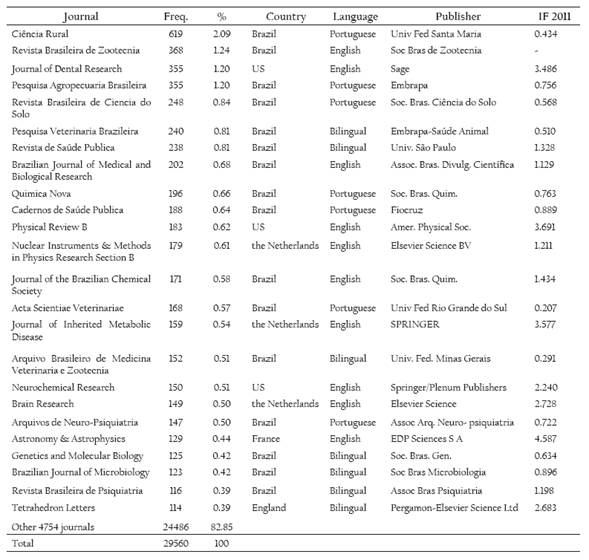
Velho (2008) drives a controversy as she states that, under the pressure of evaluation processes, researchers in applied areas such as Agricultural Sciences let go of local and national topics and the multidisciplinary focus - both so necessary to generate relevant results for society - to dedicate themselves to topics ‘publishable’ in international journals. She also underscores that, in the particular case of Agricultural Sciences, considering agricultural problems tend to be localized, merely transferring results from one country to another, or from one area to another in the same country, does not apply most of the time. That is why the research interest tends to be national, regional, and even local, and contrary to the more comprehensive basic or natural sciences that may reach even other countries, its results tend to be published in national journals written in national languages. This study has partially confirmed that because, out of the 24 journals recording the RS output the most, seven are dedicated to Agricultural Sciences and published in Brazil, possibly containing research results of national interest.
Still in Table 2, we find an incidence of journals published by scientific associations, such as animal science, soil science, chemistry, and others. Witter (2007) indicates associations are important for the growth of science as she points out that, in order to reach their targets and achieve their expected goals, they are required to play several roles. The main role is that of encouraging scientific production, and to do that they usually resort to holding events, setting up specific interest groups, organizing social networks between their members, and collaborating with the field’s information systems. Another role includes disseminating scientific results via events, databases and publications. Publication is possibly the strategy with the longest-lasting effect and potential to boost production.
Table 3 shows the RS scientific output numbers related to the fields of knowledge to which they belong. The classification adopted is the one proposed by Glänzel and Schubert (2003), which groups the WoS areas into 12 categories for bibliometric analysis. Unlike the national scientific output, the prevailing field of publication among RS scientists is Medicine, at 13.78%. Engineering fields are next, at a slightly lower rate (13.28%) than the previous field, in keeping with the national pattern, which places Engineering fields second in the productivity ranking in 2001-2010 (Leta, 2012; Vanz & Stumpf, 2012).
The prevalence of Engineering fields also shatters the expectation created by the analysis of journal titles with greater publication frequency (Table 2), in which Agriculture journals took up the top spots. The explanation for such discrepancy can be found in the fact that Agriculture-related output is concentrated in a few journals, especially national ones. On the other hand, the publication sources for Health and Biological Sciences and Engineering fields are branched out, in part because they publish in international journals.
The rate of articles published in agriculture-dedicated journals in this study (9.26%) may be related to the state’s farming vocation and the increase in the number of Brazilian journals indexed by WoS. Rio Grande do Sul once hosted the second agriculture college in Brazil, Imperial Escola de Medicina Veterinária e de Agricultura Prática (Imperial School of Veterinary Medicine and Practical Agriculture), created in the city of Pelotas in 1883, back when Brazil was still an eminently farming empire (Capdeville, 1991). The school has been a part of Universidade Federal de Pelotas since 1969. Today, the state boasts 29 stricto sensu graduate programs in the field of agriculture and houses four EMBRAPA units.
The results found partially corroborate those previously presented by Albuquerque et al. (2002), who listed the fields of Health and Agricultural Sciences as the leading scientific specialties in RS.
The authors’ analysis found 45535 authors involved in the 29560 documents published by the State of Rio Grande do Sul. A group of 49 authors published more than 100 articles in the period, turning out a total of 7366 documents which account for 24.98% of the state’s overall output in the period (n= 29,560). The most prolific authors include Wajner, M (325 documents), Rocha, JBT (299 documents), Giugliani, R (292 documents), Souza, DO (265 documents), Kapczinski, FP (249 documents), Nogueira CW (234 documents), Wyse, ATS (232 documents), and Izquierdo, I (207 documents), dedicated to fields like biochemistry, memory, and genetics. Those connected to UFRGS contributed 58.25% of the 7366 publications, while scientists associated with UFSM contributed 27.37%. The numbers confirm the two federal institutions’ prominent position in the Rio Grande do Sul scene, although researchers from Pontifícia Universidade Católica do Rio Grande do Sul (PUCRS), Universidade Federal de Pelotas (UFPel), and Universidade de Caxias do Sul (UCS) also feature in the ranking.
Upon analyzing the collaboration between those authors we find that only 3.80% of the publications are solo efforts, indicating that 96.2% of the publications are authored collectively. We also find that publications with two, three, four, five, six, seven and eight authors make up the most significant group, accounting for 86.95% of the total. The number of RS publications co-authored by large research groups is lower and less representative. The largest team co-authoring one of those documents comprises 417 researchers. On average, each publication has 5.13 authors and 4 as a median.
The state’s ranking of most prolific authors showed that all the top positions are held by authors associated with universities, which are considered the main driving forces behind a country’s research development (Solla Price, 1963). In Brazil, the science and technology system is affiliated to public universities and institutes (Leta, 2012). In RS, that fact also holds true when we look at institutions with which the authors are associated: out of the 30 most productive RS institutions, 20 are universities, as shown in Table 4 (see next page).
Brazilian science is extremely concentrated in the public sector as 70% of Brazilian scientists work in public universities and research institutes, according to data from Leta et al. (2006). The authors believe changing that scenario will be a challenge that should be tackled in the next few years, and highlight it is important to expand and decentralize the Brazilian science, technology and innovation system in order to create mechanisms to increase the manufacturing industry’s involvement in such activities. Absorbing and creating new jobs and positions for the thousands of new PhDs getting their degrees every year should also be in the agenda of discussions between the manufacturing industry, universities, and the government. Table 4 data ratify the authors’ statement and make it possible to see that, in the group of 30 institutions at the top of the RS output ranking in the period, 14 are public institutions funded by either the federal or state government. Regarding private institutions, several receive incentives and funds from governmental agencies like CAPES, CNPq, and Fapergs, besides Ministries such as Education and Health.
Featuring among the most prolific institutions is EMBRAPA, a national farming and animal husbandry research institution standing among the most prolific nationwide as well (Leta et al. 2006; Vanz & Stumpf 2012). Although listed in the ranking with a lower number of publications, medical institutions showed up as well, such as Instituto de Cardiologia do Rio Grande do Sul, Grupo Hospitalar Conceição, Hospital Moinhos de Vento, and Hospital Mãe de Deus, all of them located in the state capital, Porto Alegre.
UFRGS, the most prolific institution in RS, is the university that pioneered higher education in Rio Grande do Sul by creating its Pharmacy and Chemistry School in 1895 and the Engineering School soon thereafter. Today UFRGS stands among the top Brazilian research institutions when it comes to output and citations (Vanz & Stumpf, 2012; Brambilla & Stumpf, 2012).
Table 4 Most prolific RS institutions in WoS from 2000 to 2010, home city, and respective number of publications.
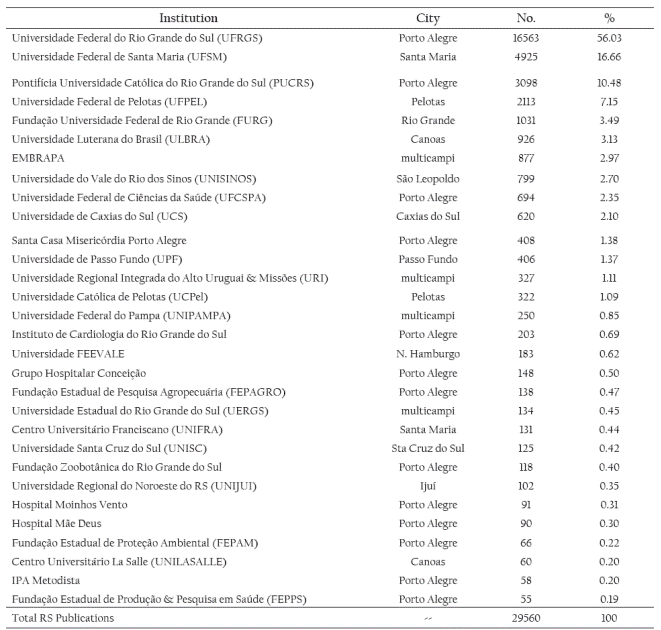
Source: Research data.
Brazilian research institutions when it comes to output and citations (Vanz & Stumpf, 2012; Brambilla & Stumpf, 2012).
Among others reasons, identifying the institutions and areas showing high scientific performance is important in order to establish scientific policies and subsequently evaluate their results (Packer & Meneghini, 2006). We find a large concentration of institutions in the capital, Porto Alegre, and in the metropolitan area, in cities such as São Leopoldo, Novo Hamburgo and Canoas. In northeast RS, the cities of Passo Fundo and Ijuí stand out. Caxias do Sul represents the state’s mountain area. In central RS, the cities of Santa Cruz do Sul and Santa Maria are represented by two institutions. In the south, Pelotas and Rio Grande are prominent. The area along the border with Argentina and Uruguay still lacks greater representation, although there are new institutions like UERGS and UNIPAMPA.
With respect to the collaboration between institutions, the state shows an average of 2.19 and a median of 2 co-author institutions per publication, very similar to the national average of 2.4 institutions per publication (Vanz & Stumpf, 2012). Although the average and median point to the existence of collaboration between institutions, the fact that 43.51% of publications are associated with a single institution indicates that collaboration between different institutions is yet to become a usual practice in the state. According to Table 5, if the subsequent positions are added up, we find that 51.06% of the RS scientific studies are conducted via collaboration between two, three and four institutions. Collaborations involving a higher number of institutions are insignificante.
Table 5 Number of co-author institutions linked to RS pu blications in WoS 2000 - 2010.

Source: Research data.
In order to examine the author institutions’ behavioral patterns, we conducted cluster and network analyses on the 100 most prolific institutions. Among that group of 100 institutions, we found RS institutions and some located in other states, such as Universidade Federal do Rio de Janeiro (UFRJ), Universidade Estadual de Campinas (UNICAMP), Universidade Federal de Santa Catarina (UFSC), Universidade de São Paulo (USP), Universidade Federal do Paraná (UFPR), Universidade Federal de São Paulo (UNIFESP), and Universidade Estadual Júlio de Mesquita (UNESP), among others, which feature at the top of the ranking because the number of publications in collaboration with RS institutions is higher than the number of publications by less prolific RS institutions, like some shown in Table 4.
Figure 2. Map of the collaboration between RS and partner institutions in WoS in 2000 through 2010. Research data.
The cluster analysis on the collaboration between the top 100 institutions in the ranking corroborates the descriptive analyses, as it does not show the formation of strongly connected work groups. The map reveals the non-collaborative stance of RS institutions and does not indicate joint efforts that may be analyzed. UFRGS shows up isolated at the center, which may be explained by the fact that the school has already cemented itself in the RS scene and is compelled to seek partnerships outside the state and, perhaps, outside Brazil. Other studies have reported UFRGS' partnerships with other national institutions in the agriculture and biotechnology fields (Costa, Pedro & Macedo, 2013). Close to UFRGS we find UCS, UPF and PUCRS, all of them in Rio Grande do Sul.
FURG and UFPEL, federal universities located in southern Rio Grande do Sul, are seen nearby, although they do not belong to the same cluster. UFSM shares the same cluster with UFPEL, EMBRAPA and UNIPAMPA
At the top of the map we find medical research institutions, all of them belonging to the same group: Instituto de Cardiologia, UFCSPA, Hospital Mãe de Deus, Hospital Moinhos de Vento.
The institutions located in other states, such as UFRJ, UNICAMP, UFSC, USP, UFPR, UNIFESP, and UNESP, are located in the neighboring states of Santa Catarina, Paraná, São Paulo, and Rio de Janeiro, all of them located geographically close to Rio Grande do Sul. The USP, Unicamp, Unesp, and UFRJ universities are partners in the field of biotechnology, as shown in previous studies (Moura & Caregnato, 2010). USP also accounts for nearly 30% of the Brazilian scientific output related to health sciences (Leta, Pereira & Chaimovich, 2005), which may also explain its work as a Rio Grande do Sul partner considering that health sciences are the main field of research in the state.
We also see foreign institutions that make up a separate cluster because they do not work closely with RS institutions.
We found that 6816 documents (23.22%) were published in international collaboration. Most documents published in international collaboration are co-authored with just one other country (5167 documents, representing 75.8% of the publications in international collaboration). Rio Grande do Sul's partnership with another two countries is at a much lower level (980 documents, 14.38%). The state's results seem in keeping with the facts described in the literature, where we find reports that 17% of all coauthored articles indexed in SCI in 2000 were signed by more than 2 countries (Glänzel & Schubert, 2003); in 2005, 23.3% of the scientific output indexed by SCI was co-authored internationally (Leydesdorff & Wagner, 2009). Upon analyzing the Brazilian scientific output, we find 30.3% of international articles in the period 2004-2006 (Vanz, 2009).
The countries with which RS researchers collaborate include the United States of America, present in 21.86% of the RS output, followed by European countries such as Germany (co-authoring 8.17%), France (7.37%), the United Kingdom (6.66%), Spain (5.31%) and Italy (3.91%). Argentina stands out among Latin American countries, with a share of 6.35% in the documents published. The collaboration with the State of Rio Grande do Sul's neighboring country is much greater than the collaboration Brazil conducts with that country, which is at 3.8% (Vanz & Stumpf, 2012).
Among the bases for the Brazilian scientific collaboration, according to Costa et al. (2013), is the focus on the cooperation with the United States in the fields of health, the environment, and energy; and the collaboration with the European Union in fields such as health, biotechnology, nanotechnology, agriculture, energy, and the environment. Such areas of interest are the ones RS is most prolific in, a result that may also be related to the countries with which the state collaborates.
4. Final Considerations
The RS scientific output represented in the WoS base between 2000 and 2010 shows an increase adjusted to the exponential and constant, except for 2006, when the output dropped. That growth is higher than the increase in the Brazilian scientific output when we compare the percentage data related to some of the years analyzed, such as 2001, 2003, 2005, 2008 and 2009. The documents are published mostly in the article format (71.71%) and in English (84.89%).
The output is distributed in a large number of journals, but we find those published in Brazil are prevalent, especially in the field of Agricultural Sciences. Considering that field is not the one published the most in the state, according to an analysis of fields, we assume that more prolific fields such as Clinical Medicine, Engineering and Biological Sciences have a less endogenous behavior and publish in foreign, more diverse journals. It seems Agricultural Sciences behave towards publishing domestically, and that is why documents published in journals related to this field prevail.
The analysis of authors shows the most prolific ones are associated with UFRGS, UFSM, UFPEL, UCS, and PUCRS. Those institutions also show up in the institutional productivity analysis, which shows that out of the 30 most prolific RS institutions, 20 are universities. Scientific production is concentrated mainly in the capital, Porto Alegre, and in the central area, specifically in the city of Santa Maria. Collaboration-wise, the analyses show there is collaboration between authors. On the other hand, collaboration between institutions is still timid, considering 43.51% of the publications come from a single institution.
Internationally, collaboration is found in 23.22% of the documents put out by Rio Grande do Sul. The main partners are the US, Germany, France, the UK, and Argentina. The fact the state borders Argentina makes the collaboration with that country greater than the one found when Brazil is concerned.
Studying the collaboration between RS and the other Brazilian states, as well as the collaboration between RS and other countries, may help take the results presented herein to a higher level. It should be noted that the RS scientific production is undoubtedly larger than the outlook presented in this paper, which addresses solely the publications indexed in WoS. Although this study is neither exhaustive nor conclusive, the purpose is to help foster discussions.
We believe this study is an important stepping stone for society and development agencies to have information about the research work conducted in the state of Rio Grande do Sul













